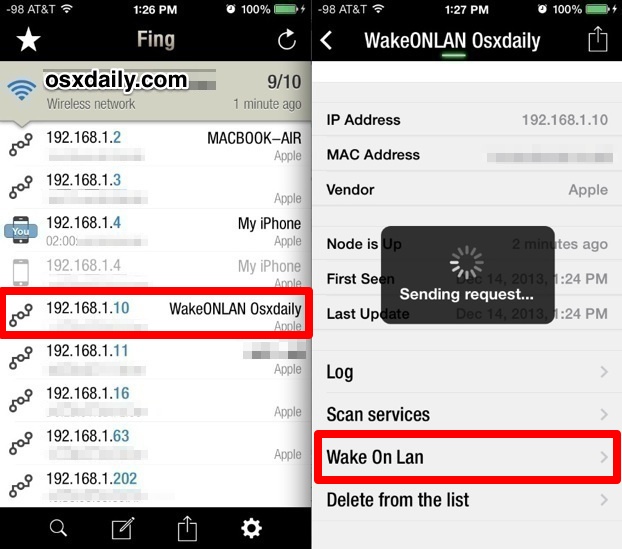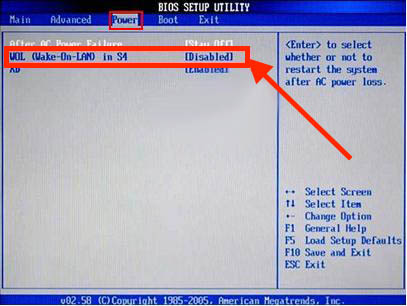You can turn on an offline computer with TeamViewer via Wake-on-LAN. This way, you can control an offline computer remotely by waking it up before you establish a connection. Wake-on-LAN can be used through two different methods: A. Wake up a computer (hereinafter named as target computer) via another computer within the same network. To activate Wake-on-LAN for the network card under Mac OS X, follow these steps: 1. Open the System Settings. TeamViewer 10 Manual Wake-on-LAN www.teamviewer.com Page 8 of 13 Configure TeamViewer The System Settings window will open. Click Save Energy. Wake On Lan for Apple Mac OS X 10.6+ Is available on the Mac App Store. Get It Now - On The Mac App Store. Wake On Lan Command Line for OS X. For those that prefer to things from Terminal or via a script you can now download WoL for the command line. Support Communities / Mac OS & System Software / Mac OS X Technologies Looks like no one's replied in a while. To start the conversation again, simply ask a new question. User profile for user: GalenLezmor. Question: Q: Enable Wake On LAN (WOL) from terminal command line. Wake on LAN is a feature built into the NIC (the Ethernet card), and then the OS must support it too. This is one of the things, in the PC world, that determines one the differences between a manufacturer's home computer line (like Compaq Prosario), and business computer line (like Compaq Deskpro).
2020-09-10 17:49:32 • Filed to: macOS 10.14 • Proven solutions
It's common for Mac users to be taken unawares by an apparent failure of the sleep-wake functionality of their Macs. As a macOS Mojave user, you may be astounded to find yourself asking what you should do if your mac won't turn on because you've probably presumed that this issue, which has plagued the previous versions, has been addressed in the latest MacOS update. No worries, here will tell you how to fix your Mac not waking from sleep on macOS 10.14 easily and quickly.
How to Fix Your Mac Not Waking Up on macOS 10.14
After installing the macOS 10.14 updates, a user can run into issues with the Mac's sleep and wake functions wherein the Mac refuses to wake when expected or the OS fails to launch after going to sleep, even after the power button or any button on the keyboard is pressed ad nauseam. In another variation of this issue, the Mac might take far too long to wake up. In other cases, it takes multiple clicks of the mouse or keyboard buttons to wake the Mac up. But in the cases where the system doesn't respond to the push of any button.
The Sleep and Wake activities of Macs are normally regulated by user settings, app activities, connected devices and networks. That implies that most users encountering this issue might think it's a technically intricate task to fix a Mac that won't wake up on macOS 10.14.
However, there are several easy ways to fix a Mac that won't wake up on macOS 10.14. The first thing to do when you notice the sleep and wake functions of your Mac are malfunctioning is to see if there are certain settings that may have triggered this development. Ensure that your Mac's screen brightness isn't turned down, your external display isn't turned off, your Mac isn't in safe sleep, and that the Mac isn't turned off.
If you're still short of answers as per how to fix macbook won't turn on on macOS 10.14, you can get cracking on the following steps to find your way around:
1. Disable System Hibernation:

Note that the hibernation mode is only a preventive measure to prevent the loss of data during a loss of power, you might be able to do without its intervention. To turn off the hibernation mode, run the following commands in the OS X Terminal:
sudo pmset standby 0
sudo pmset autopoweroff 0
These two commands disable the settings of the hardware responsible for the hibernation mode. These include the Apple's main standby mode option, and a functionality installed in accordance to regulations of European energy. To revert the settings, simply reset your Mac's system management controller. Another way is to run the commands again, this time replacing the '0' with '1'.
2. Reset FileVault
A glitch may impede the storage and retrieval of file contents on the hard disk during hibernation, causing conflicts between full disk encryption protocols like FileVault, which in turn prevent the authentication and loading of hibernation files, leading to a crash as the system wakes up. To resolve this, disable the full-disk encryption protocols, and re-enable them if the hibernation works fine after the disk is fully decrypted.
3. Clear Out Hibernation Files
Is mac better than pc for programming. When the system figures that a hibernation file (files written on the hard disk by the hibernation function) is missing, it recreates the file. But if it does so erroneously, it might damage the file, preventing reading from the system when waking up. To fix, force the system to recreate the files again by the run of the following command:
After effects cc 2017 crack. sudo rm /var/vm/sleepimage

Free Download or Buy PDFelement right now!
Free Download or Buy PDFelement right now!
Buy PDFelement right now!
Buy PDFelement right now!

Note that the hibernation mode is only a preventive measure to prevent the loss of data during a loss of power, you might be able to do without its intervention. To turn off the hibernation mode, run the following commands in the OS X Terminal:
sudo pmset standby 0
sudo pmset autopoweroff 0
These two commands disable the settings of the hardware responsible for the hibernation mode. These include the Apple's main standby mode option, and a functionality installed in accordance to regulations of European energy. To revert the settings, simply reset your Mac's system management controller. Another way is to run the commands again, this time replacing the '0' with '1'.
2. Reset FileVault
A glitch may impede the storage and retrieval of file contents on the hard disk during hibernation, causing conflicts between full disk encryption protocols like FileVault, which in turn prevent the authentication and loading of hibernation files, leading to a crash as the system wakes up. To resolve this, disable the full-disk encryption protocols, and re-enable them if the hibernation works fine after the disk is fully decrypted.
3. Clear Out Hibernation Files
Is mac better than pc for programming. When the system figures that a hibernation file (files written on the hard disk by the hibernation function) is missing, it recreates the file. But if it does so erroneously, it might damage the file, preventing reading from the system when waking up. To fix, force the system to recreate the files again by the run of the following command:
After effects cc 2017 crack. sudo rm /var/vm/sleepimage
Free Download or Buy PDFelement right now!
Free Download or Buy PDFelement right now!
Buy PDFelement right now!
Buy PDFelement right now!
Introduction
Wake On Lan Macos App
Wake on LAN (or WOL) allows you to remotely turn on a computer.
Note: WOL is available only on OS X 10.11 (El Capitan) or later.
Wake On Lan For Mac Osx
Enabling WOL on OS X
To enable WOL, do the following:
If you're going to let go of the Microsoft world, your best bet is to join the Google. Office is free for mac. Start quickly with the most recent versions of Word, Excel, PowerPoint, Outlook, OneNote and OneDrive —combining the familiarity of Office and the unique Mac features you love. Work online or offline, on your own or with others in real time—whatever works for what you're doing. It contains the state of the art authoring and reviewing tools in Word that makes the.
Wake On Lan For Mac Os 10.13
- For OSX it can be enabled from System Preferences ->Energy Saver by turning on Wake for network access.
- Restart the computer and boot into Recovery mode by holding CMD+R on boot until the Apple logo appears.
- Open Terminal from the Utilities menu.
- Disable System Integrity Protection by running the csrutil disable; reboot command.
- After OSX boots up, make sure you're logging in as an administrator and open Terminal from /Applications/Utilities/Terminal.app
- Log in as root by running the sudo -i command in the terminal window.
- Edit the boot configuration file by running the vim /Library/Preferences/SystemConfiguration/com.apple.Boot.plist command.
- Press i to enter Insert mode. Find the Kernel Flags and change it to Kernel Flags darkwake=0
- Press Esc, then input :wq and press Enter to save the file and quit vim.
- Run the reboot command.
- Boot into Recovery mode by holding CMD+R on boot time.
- Open Terminal from Utilities menu.
- Re-enable System Integrity Protection by running the csrutil enable; reboot command.
- After OSX boots up, disable the Password Requirement after sleep, by opening System Preferences >Security & Privacy, selecting the General tab, and unchecking the Require password field.
